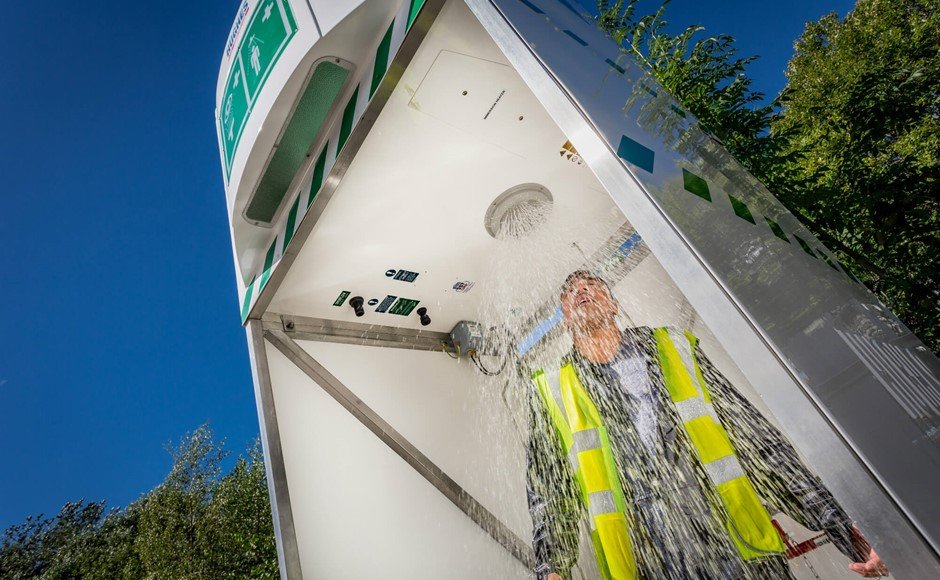Despite the various control measures put in place to protect them, exposure to hazardous substances remains a threat to workers in almost every industry. And when exposure does happen, it’s critical that the worker be able to treat it right away in order to reduce the damage and prevent further complications. Emergency showers and eyewashes (ESEW) allow affected workers to immediately wash the substance off their skin and eyes. But there is an important caveat: the water must be tepid. What does that mean, exactly?
In this article, I’ll help you understand what tepid water means in an occupational safety context, why it’s so important, and how you can ensure your emergency shower and eyewash provides it.
Also Read: Eyewash and Emergency Shower Safety

What Does “Tepid” Mean, Exactly?
By ANSI definition, tepid water is temperature-controlled water that sits between 60°F and 100°F. This is, however, a very broad guideline. Water temperature that falls within this range is not necessarily appropriate for every affected user. For one thing, some chemicals will have adverse reactions to the water of a certain temperature. It’s also important that the water temperature is comfortable for the worker. What temperatures are comfortable, however, will depend on a few factors, such as whether the shower is located outdoors or indoors, the ambient temperature in the work area, and the level of physical exertion at the time of injury.
Making sure the water is at a comfortable temperature is not just a luxury – it’s important to ensure a worker’s safety. To make sure all hazardous substances have been washed off, workers should stay in the emergency shower for 15 minutes. Water that is too hot or too cold, however, may cause the worker to step out of the shower before a complete wash, reducing its effectiveness and increasing the chances of an injury from chemical burns.
Water that isn’t tepid can also cause injuries in its own right. Too hot, and the water could burn the user; too cold and it could lead to hypothermia. Emergency shower users are less likely to remove contaminated clothing in cold water, as well, which prolongs their exposure to harmful chemical substances. In both cases, the temperature of the water can significantly exacerbate the severity of the injury.
It’s important for you to evaluate exactly what “tepid water” means to you. While you must conform to the temperatures set out in ANSI’s definition to be compliant, you can establish your own definition within that range. After all, few people could remain in a 60°F shower for 15 minutes, and perhaps fewer still could stand under 100°F water for any length of time. For most people, the comfortable range typically falls between about 80°F and 90°F – and this should be a prime consideration when you’re evaluating your tepid water provision options.
Standards for Tepid Water in Emergency Showers
OSHA specifies that:
Where the eyes or body of any person may be exposed to injurious corrosive materials, suitable facilities for quick drenching or flushing of the eyes and body shall be provided within the work area for immediate emergency use.
However, they don’t go further into explaining what this really means
This is where ANSI standards come into play. The Z358.1-2014 Standard provides a more specific guideline and builds on OSHA’s recommendations and offers insight into what is “suitable” when it comes to emergency showers (and eyewash stations).
The standard states that emergency showers and eyewash stations must be located within 10 seconds (approximately 55 feet) from the hazard, with a clear, unobstructed path. It also specifies, in a nutshell, that:
- The water must be tepid, at a temperature that falls between 60°F and 100°F
- The shower must be able to flow at a minimum of 20 gallons per minute for 15 minutes, while the eyewash station must be able to flow at a minimum of 0.4 gallons per minute (eye/facewash at 3 GPM) for 15 minutes (for units that combine both, each feature must meet these requirements simultaneously)
- If the local climate has the potential for freezing conditions, the equipment should be designed to protect against those conditions
Following these standards is the best way to ensure your emergency safety shower is up to the task for the job it needs to do.
5 Solutions to Ensure Tepid Water at All Times
There are a number of different ways you can ensure that your emergency showers produce tepid water at all times. Here, I’ll break the most common ones down for you.
1. Point of Use ESEW Equipment
This category of shower and eyewash equipment includes low-pressure steam units that take up little space and are typically used for heating water in colder climates.
Electrical tempering can include heated vessels or tankless heaters that provide hot water to be thermostatically mixed with cold potable water from the plant’s infrastructure.
2. Tepid Water Loop Systems
This type of solution has a centralized tempering system that controls the water with an engineered mixing valve using available infrastructure water and a hot water source (a boiler or an electrically powered or steam-powered skid-mounted vessel). The water is pumped through a pipework loop to the shower (and often eyewash) equipment. It recirculates until needed, and the system continually ensures that the proper temperature at all potential points of use is available within one second to comply with the ANSI standard.
Also read: Keys to Sustainable Safety and Ergonomics
3. Electrical and Steam Tempering
Electrical tempering is one of the most common methods of securing consistently tepid water. Similar to the process used in most homes, electricity heats an industrial tank vessel that holds anywhere from 160 to 400 gallons of water. The hot water – which frequently reaches 160°F – blends with cold water to ensure it’s tepid upon delivery.
Steam tempering works in much the same way but uses infrastructure steam that blends hot water with cold to create a tepid temperature that won’t harm the shower user. Point of use systems uses low-pressure steam, mixing the hot and cold water right at the point of use.
4. Emergency Tank Showers
This type of solution is ideal for situations that lack constant water supply or where water pressure is unreliable. The showers are insulated and heated by immersion heaters that help keep the water a consistent temperature.
These units can be customized based on the context and environmental conditions. They are protected against freezing in extremely cold climates and employ chiller units to keep water temperatures in the tepid range for extremely hot climates.
Read more anoutEmergency Eyewash Stations: What the Z358 Standard Means for Your Workplace
5. Solar Powered Tempering
Few solar options currently exist for emergency safety showers – but that doesn’t mean the industry won’t look at this heating method in the future. Unfortunately, solar heating solutions aren’t ideal for colder, northern climates, since those regions don’t get much solar load in the winter (when water heating is most needed). Soon, however, we will see solar solutions emerge in warmer climates as a green alternative to electrical heating.
Costs of Keeping Safety Shower Water Tepid
When it comes to tepid water solutions, there are two cost categories to consider: construction costs and operating costs.
Construction Costs
In terms of construction, a solution that uses thermostatic mixing valves at every fixture is going to cost more than one that employs the recirculating loop method.
Systems that require custom solutions for extreme conditions will also be higher in cost.
Operating Costs
Some tepid water solutions come with added costs due to increased energy consumption. Tankless systems, for instance, use a significant amount of energy. Immersion heaters, on the other hand, use far less, while low-pressure steam heaters require no power whatsoever.
For systems that have tanks, insulation is an important consideration, too, as sufficient insulation can minimize stand-by heat loss and decrease operating costs significantly.
Don’t Cut Corners
While cost is certainly a factor for many businesses, it shouldn’t be the deciding factor.
The emphasis must be placed on finding the most appropriate solution to keep your workers safe – and in the long run, you’ll probably find that the increase in morale and decrease in the severity of injuries makes it well worth the investment.
Conclusion
Which tepid water solution is the right one depends very much on the context? Each business will need something a little different than the next.
But the one thing that remains constant across every business is the need for reliable tepid water. It can make the difference between a minor injury and a serious one that hasn’t been properly treated. And that’s not a risk any business should take.
Also read: A Guide to Eye Wash and Emergency Shower Stations
Have many safety Resources at Safetybagresources.com



